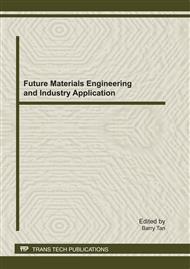[1]
O. Pinkus, Analysis and Characteristics of Three-Lobe Bearings, ASME Journal of Basic Engineering, vol. 81, (1959. ) , p.19.
Google Scholar
[2]
J. W. Lund, and K. K. Thomson, A Calculation Method and Data for the Dynamic Coefficients of Oil Lubricated Journal Bearings, Proceedings of the ASME Design and Engineering Conference, Minneapolis, (1978) p.1.
Google Scholar
[3]
M. Malik, Mahesh Chandra and R. Sinhasan, Design Data for Offset-Halves Journal Bearings in Laminar and Turbulent Flow Regimes, ASLE Trans., (1982), pp.133-140.
DOI: 10.1080/05698198208983075
Google Scholar
[4]
N. P. Mehta, A. Singh, and B. K. Gupta, Dynamic Analysis of Finite Half-Elliptical Pressure Dam Bearings with Rotor Flexibility Effects, ASLE Trans., vol. 29, no. 1, ( 1986) pp.61-66.
DOI: 10.1080/05698198608981660
Google Scholar
[5]
J. C. Nicholas and Allaire, P.E., Analysis of Step Journal Bearings- Finite Length Stability, ASLE Trans., (1980), pp.197-207.
Google Scholar
[6]
J. C. Nicholas, L. E. Barrett, and M. E. Leader, Experimental – Theoretical Comparison of Instability Onset Speeds for a Three Mass Rotor Supported by Step Journal Bearing, Trans. ASME, Journal of Mechanical Design, ( 1980) pp.344-351.
DOI: 10.1115/1.3254750
Google Scholar
[7]
R. D. Flack, M. E. Leader, and E. J. Gunter, An Experimental Investigation on the Response of a Flexible Rotor Mounted in Pressure Dam Bearings, Trans. ASME, Journal of Mechanical Design, (1980), pp.842-850.
DOI: 10.1115/1.3254831
Google Scholar
[8]
N. P. Mehta, and S. S. Rattan, Performance of Three-Lobe Pressure Dam Bearings, Wear, (1993), pp.181-185.
DOI: 10.1016/0043-1648(93)90323-e
Google Scholar
[9]
N. P. Mehta, S. S. Rattan and G. Bhushan, Static and Dynamic Characteristics of Four-Lobe Pressure Dam Bearings, Tribology Letters, vol. 15, no. 4, (2003), pp.415-420.
DOI: 10.1023/b:tril.0000003067.33680.11
Google Scholar
[10]
N.P. Mehta, S.S. Rattan, and Rajiv Verma, Stability Analysis of Two Lobe Hydrodynamic Journal Bearing With Couple Stress Lubricant, ARPN Journal of Engg. And Applied Sciences, vol. 5, no1, (2010), pp.69-74.
Google Scholar
[11]
G. Bhushan, S. S. Rattan, and N. P. Mehta, Stability Analysis of Four-Lobe Pressure Dam bearings, Tribology Letters, vol. 13, no. 1, (2002) pp.1-7.
Google Scholar
[12]
Malik, R. Sinhasan and M. Chandra, A Comparative Study of Some Three-lobe Bearing Configurations, Wear, (1981), pp.277-286.
DOI: 10.1016/0043-1648(81)90254-4
Google Scholar
[13]
Booker, G.F. and Hubner, K.H., Application of Finite Elements to Lubrication: An Engineering Approach, Trans ASME, Journal of Lubrication Technology, (1972), pp.313-323.
DOI: 10.1115/1.3451719
Google Scholar
[14]
J .F. Booker and P.K. Goenka, Spherical Bearings: Static and Dynamic Analysis via the Finite Element Method, Trans. ASME J. Lub. Technology, (1980).
DOI: 10.1115/1.3251522
Google Scholar
[15]
E .J. Hahn, The Excitability of Flexibility Rotors in Short Sleeve Bearings, Trans. ASME Journal of. Lubrication Technology, (1975), pp.196-205.
Google Scholar


